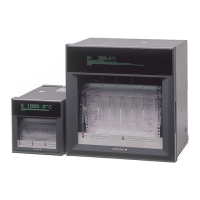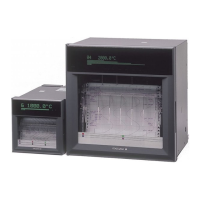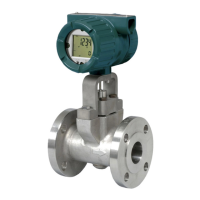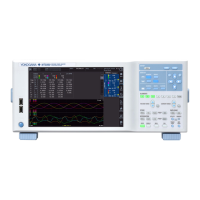IM 04P01B01-01E
1-8
For the procedure to set the functions, see section 1.10, “Function Setup Guide.”
• Delay High Limit Alarm (T)
An alarm occurs when the measured value remains above the alarm value for a
speciedtimeperiod(alarmdelayperiod).
• Delay Low Limit Alarm (t)
An alarm occurs when the measured value remains below the alarm value for a
speciedtimeperiod(alarmdelayperiod).
Delay High Limit Alarm Example (T denotes the specified delay)
Alarm releaseAlarm occurrence
T
X1 X2 X3 X4
T1
Measured value
• AlarmdoesnotoccuratT1,becausethetimeperiodisshorterthanthespecied
alarm delay period (T).
• The measured value exceeds the alarm value at time X2, and the alarm occurs at
timeX3atwhichthespeciedalarmdelayperiodelapses(thetimewhenthealarm
occurs is the time at X3).
• The measured value falls below the alarm value at time X4, and the alarm is
released.
Note
• The alarm detection operation is reset when a power failure occurs. The operation restarts
after the power recovers.
• If the alarm value is changed while a delay alarm is occurring, the alarm is released if the
new alarm value does not meet the alarm condition.
Alarm Hysteresis
Hysteresis can be specified to the values for activating and releasing the alarm. The
hysteresis applies only to high limit alarm (H) and low limit alarm (L). The hysteresis
width can be set in the range of 0.0% (Off) to 1.0% of the recording span in 0.1 steps.
The setting applies to all high limit alarms and low limit alarms. By default, the hysteresis
width is set to 0.5%.
Alarm
value
Alarm release
Measured value
Alarm occurrence
High limit alarm
Low limit alarm
Measured
value
Alarm release
Hysteresis
Alarm value
Alarm occurrence
<Related Topics> Setting alarms: Section 5.2
Setting the alarm delay function: Sections 7.15 and 6.10
Setting the alarm hysteresis: Section 7.1
1.3 Alarms

